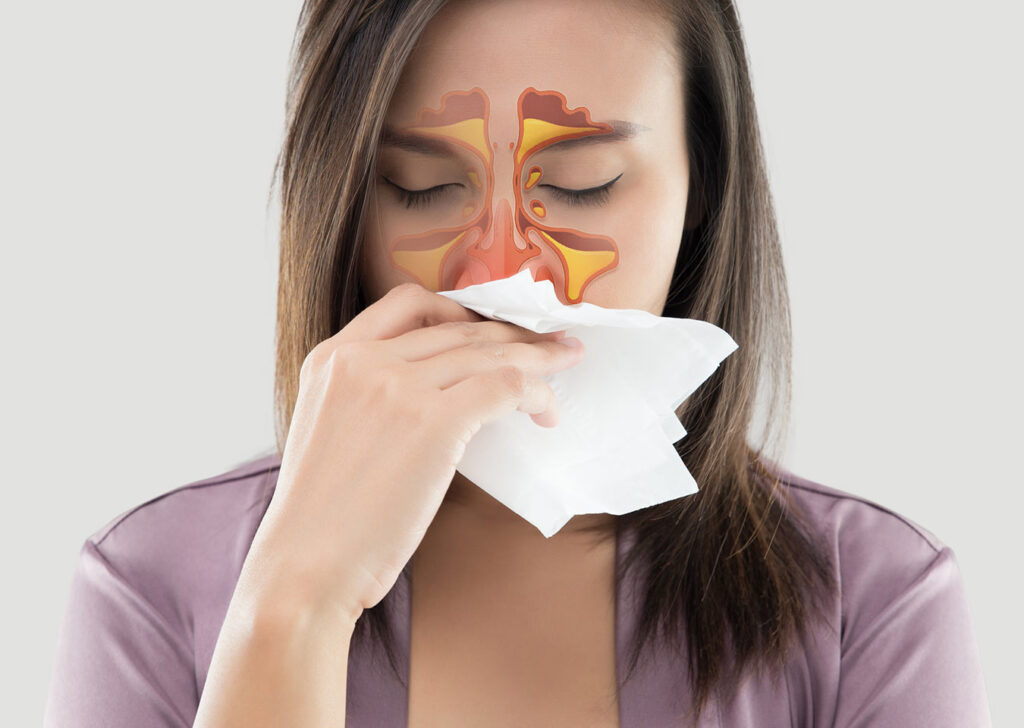Biofilm
The role of biofilms in chronic rhino-sinusitis (CRS) was recently reviewed on this blog.
If we accept that biofilm-forming bacteria cause chronic rhino-sinusitis ….
How can we use this information to treat our sinusitis?
First, physical forces are needed to remove some biofilms. For some people, this means surgical removal of the thick, tenacious bacterial matt that has accumulated. This is particularly true for those with sinusitis and cystic fibrosis.
For most people with CRS, elimination and maintenance of good nasal and sinus health may be achieved following these steps.
The 5-Step Program to Eliminate Biofilm and Sinusitis
- Start with Saline Rinses (I use Nasopure)Nasal saline rinses. Nasal Saline Rinsing as a remedy for sinusitis has been amply covered here on this blog.
- The second thing to do is to add something to the saline rinses that will help dissolve the biofilm. Like what? Baby Shampoo. Really.
It’s called a surfactant, and it helps dissolve biofilms.
Physician-scientists at the University of Pennsylvania studied the addition of 1% baby shampoo to nasal saline rinses. They found that the baby shampoo helped reduce the thick, viscous secretions and postnasal drainage in patients with CRS in 60% of their patients. Their study was reported in 2008 in the American Journal of Rhinology.
Note that although they conclude that the “baby shampoo had no effect on the eradication of pre-formed Psuedomonas biofilms,” they also concluded that “60% of patients noted improvement in specific symptoms…”
In a more recent article, this same group concluded that baby shampoo therapy “… shows in vitro antimicrobial effects with modest inhibition of bacterial biofilm inhibition.”
My conclusion? It works. But heed the following caution:
CAUTION: don’t use too much – it burns (I know from personal experience). A few drops in the bottle should do it.

- We know which bacteria are best at forming biofilms – staph and pseudomonas are pretty good at it. That includes MRSA. Several studies have now shown that HONEY is a great natural antibiotic! It is very effective against staph and pseudomonas. You can simply add some honey to your nasal saline rinses to benefit from this natural antibiotic.
- The addition of antibiotics to the saline rinses. A review of the medical literature on the use of antibiotics added to nasal saline rinses to treat CRS concluded that they are effective. The full-text pdf can be downloaded from the link here.
- Using a pulse-irrigator for really resistant CRS may help flush out the biofilms. There have been very few controlled clinical trials that evaluate pulse-irrigation for nasal rinses to treat CRS, but this study from the University of California, San Diego, supports the use of “water-pic-like” pulse irrigators. I recommend these for my patients with very resistant CRS.
- Finally, because the adenoids have been found to be a reservoir for the biofilm-producing bacteria that cause CRS (link to full-text pdf; this is a beautiful study from my friends at the University of Virginia), removing the adenoid tissue can benefit those with CRS. If it comes to that, an adenoidectomy is a much more gentle surgery than either sinus surgery, or a tonsillectomy, and an adenoidectomy may eliminate CRS. As a last resort.
So, if you or your child have chronic rhino-sinusitis, start with #1 above, and move your way down the list until you achieve a cure.
Assuming That You Are Also Doing All the Other Stuff …
Working on this list assumes that you are already taking great general care of your health:
- That you have removed toxins and irritants from your life.
- That you get enough sleep to keep a healthy immune system.
- That you eat a balanced, healthy, and nutritious diet. Don’t neglect your nutrition and diet.
- Don’t neglect your sleep.
- Don’t neglect your environment:
Eliminate the various toxins in your home and work environment.
These other topics are covered here on this blog.
Resources
- Header Image Credit of Flourescent Microscope Image: Biofilm growing on stainless surface. From CDC, photo by Dr. Rodnay M. Donlan: “Biofilms: Microbial Life on Surfaces”, by Murga & Donlan, 2002. http://commons.wikimedia.org/wiki/File:Polymicrobic_biofilm_epifluorescence.jpg
- For the best nasal saline rinse system that I have found (Nasopure), and a great resource for those with children who are troubled by sinusitis or allergies – including awesome videos that show your child how to do nasal saline rinses – check out Dr. Hana’s Nasopure webiste: http://www.nasopure.com/
- Transparency: I have NO financial or other arrangements with Dr. Hana Solomon or Nasopure. I simply think that her site is a valuable resource, and the Nasopure saline rinse system is the one that I use personally, and recommend to my patients.
More to read: Top 10 Food Allergens